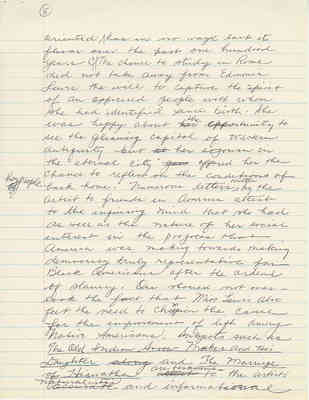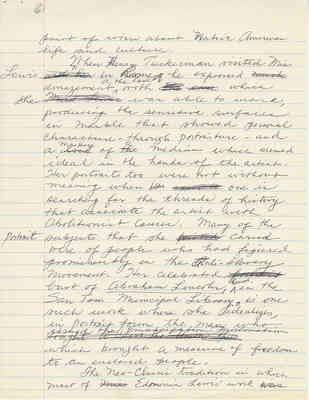Pages
MS01.01.03.B02.F10.046
oriented has in no ways lost its flavor over the part one hundred years. The chance to study in Rome did not take away from Edmonia Lewis the will to capture the spirit of an oppressed people with whom she had identified since birth. She was happy about ["her" Strike through] opportunity to see the gleaming capitaol of Western antiquity but her sojourn in the eternal city " ["gave" Strike through] offerred her the chance to reflect on the conditions of her people back home. Numerous letters written by the artist to friends in America attest to the inquiring mind that she had as well as the nature of her social interest in the progress that America was making towards making democracy truly representative for Black Americans after the ordeal of slavery. One should not over-look the fact that Miss Lewis also felt the need to Champion the Cause for the improvement of life among Native Americans. Subjects such as The Old Indian Arrow Maker an His Daughter [along Strikethrough], and The Marriage of Hiawathat are testimonies to the artist's naturalistic and informative [?]
MS01.01.03.B02.F10.047
point of view about Native American life and culture. When Henry Tuckerman visited Miss Lewis in Rome he expressed amazement at the ease with which she was able to work, producing the sensistive surfaces in marble that showed personal characture - through portraiture - and a mastery of a medium which seemed ideal in the hands of the artist. Her portraits too were not without meaning when one is searching for the threads of history that associate the artist with Abolitionist Causes. May of the portrait subjects that she carved were of people who had figured promimently in the anti-slavery movement. Her celebrated bust of Abraham Lincoln, housed in San Jose Municipal Libary, is one such work where she idealizes in portrait form the many who issued the Emancipation Proclamation which brought a measure of freedom to an enslaved people.
The Neo-Classic tradition in which most of Edmonia Lewis' work
MS01.01.03.B02.F10.048
executed was by no means an un-acceptable style of expressions existing only for those who practised art in Europe. Indeed, America had embraced this revival form of new interpretation and treatment of classical themese with eager anticipation. No doubt, Miss Lewis was very much taken by the work of Hiram Powers whose studies had taken him to Rome, Florence, and other Italian cities where he was able to see the best examples of art that Renaiassance artists had created. But the basic meaning that was to persist in Miss Lews's work was not to be tied to the style in which her subjects were executed so as much to the meaning of history and its enthnological presentation through black themes. The exact date of her death has not been accurately dtermined but it is assumed she died about 1900.




